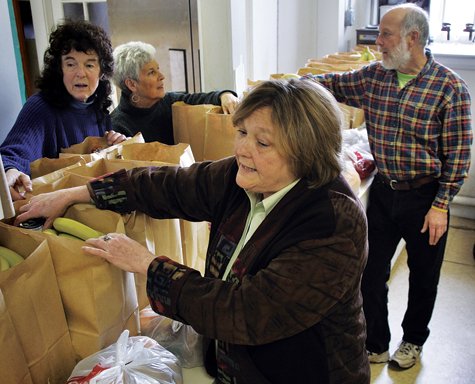ON ISLAND

Island Food Pantry
Distributing Emergency Assistance to Our Community
By Elissa Lash
Hunger is often well-concealed, but no less shameful and debilitating, and the magical community of Martha’s Vineyard is not exempt. But help is on the way.The Island Food Pantry, originally the Food Cupboard, was founded in 1981 by Helen Oliver, former pastor of Christ United Methodist. The not-for-profit is now under the care of coordinator Armen Hanjian, a retired United Methodist minister, and a staff of 70 devoted volunteers. They’re officially open for business mid-October until mid-April, Monday, Wednesday, and Friday afternoons from 2 – 4 PM, but even after they wind down for the season, “people can call us if they’re in need,” reassures Mr. Hanjian. The program receives no government support and is primarily sustained by food and money donations from individuals, churches, local farms and businesses.
They’ve been busy this year and will unfortunately stay busy until their season ends April 15th, as the Island continues to feel the effects of the nationwide financial crisis. According to the USDA, food prices are projected to rise at least another five percent this year, and as unemployment rates remain high, many individuals and families are left wondering whether to heat or eat. Volunteers at the Pantry have observed an increase in the numbers served as well as the amount of food donated this year. They surmise that the economic crisis is bringing out the best in people. “We’ve served record numbers, in March one day we helped 90 people, April saw equal that and more, that’s 270 plus bags of food.” Says Hanjian. The common perception of Martha’s Vineyard is of an affluent summer playground, but the reality of life on the Island is different. According to the latest Martha’s Vineyard Commission study, the cost of living is about 60 percent higher than on the mainland, but the average salary is more than 20 percent lower – and much of that work seasonal – many individuals and families are at risk of food insecurity. Asking for help takes courage, especially in a small community.
Mr. Hanjian is troubled that there is still a lingering misperception that people take advantage of the Food Pantry, and that these unfounded prejudices have stopped some in the community from giving. “More than half of the people who come for assistance do it only a few times a season. Rarely do people try to ‘work the system.’ We are an emergency supplement, and we can’t afford to support 100 percent of people’s needs.”
Anyone can come in for food assistance once. Repeat clients need to provide identification (a driver’s license or passport) and a letter of reference from a social agency, employer or clergy person verifying the need for assistance.Â
When planning to donate food, consider low-sodium and low-sugar products for those who are diabetic or hypertensive, as well as family-friendly foods. Ideally, the Pantry would like to offer more fresh or frozen meats and vegetables. You can contact the Island Food Pantry directly if you have a delivery of fresh fruit, vegetables, meat or eggs to donate.
If you’d like to learn more about the Island Food Pantry and their mission, log onto their website, IslandFoodPantry.org and watch the short documentary created by 13 year-old filmmaker, Josh Bernstein. You can also get information about donating or receiving food, making a tax-deductible monetary donation or volunteering by calling – 508-693-4764.
They’ve been busy this year and will unfortunately stay busy until their season ends April 15th, as the Island continues to feel the effects of the nationwide financial crisis. According to the USDA, food prices are projected to rise at least another five percent this year, and as unemployment rates remain high, many individuals and families are left wondering whether to heat or eat. Volunteers at the Pantry have observed an increase in the numbers served as well as the amount of food donated this year. They surmise that the economic crisis is bringing out the best in people. “We’ve served record numbers, in March one day we helped 90 people, April saw equal that and more, that’s 270 plus bags of food.” Says Hanjian. The common perception of Martha’s Vineyard is of an affluent summer playground, but the reality of life on the Island is different. According to the latest Martha’s Vineyard Commission study, the cost of living is about 60 percent higher than on the mainland, but the average salary is more than 20 percent lower – and much of that work seasonal – many individuals and families are at risk of food insecurity. Asking for help takes courage, especially in a small community.
Mr. Hanjian is troubled that there is still a lingering misperception that people take advantage of the Food Pantry, and that these unfounded prejudices have stopped some in the community from giving. “More than half of the people who come for assistance do it only a few times a season. Rarely do people try to ‘work the system.’ We are an emergency supplement, and we can’t afford to support 100 percent of people’s needs.”
Anyone can come in for food assistance once. Repeat clients need to provide identification (a driver’s license or passport) and a letter of reference from a social agency, employer or clergy person verifying the need for assistance.Â
When planning to donate food, consider low-sodium and low-sugar products for those who are diabetic or hypertensive, as well as family-friendly foods. Ideally, the Pantry would like to offer more fresh or frozen meats and vegetables. You can contact the Island Food Pantry directly if you have a delivery of fresh fruit, vegetables, meat or eggs to donate.
If you’d like to learn more about the Island Food Pantry and their mission, log onto their website, IslandFoodPantry.org and watch the short documentary created by 13 year-old filmmaker, Josh Bernstein. You can also get information about donating or receiving food, making a tax-deductible monetary donation or volunteering by calling – 508-693-4764.









